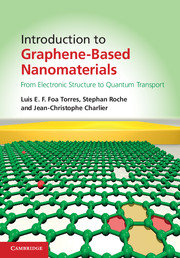Book contents
- Frontmatter
- Contents
- Preface
- 1 Introduction to carbon-based nanostructures
- 2 Electronic properties of carbon-based nanostructures
- 3 Quantum transport: general concepts
- 4 Klein tunneling and ballistic transport in graphene and related materials
- 5 Quantum transport in disordered graphene-based materials
- 6 Quantum transport beyond DC
- 7 Ab initio and multiscale quantum transport in graphene-based materials
- 8 Applications
- Appendix A Electronic structure calculations: the density functional theory (DFT)
- Appendix B Electronic structure calculations: the many-body perturbation theory (MBPT)
- Appendix C Green's functions and ab initio quantum transport in the Landauer–Büttiker formalism
- Appendix D Recursion methods for computing the DOS and wavepacket dynamics
- References
- Index
Appendix B - Electronic structure calculations: the many-body perturbation theory (MBPT)
Published online by Cambridge University Press: 05 February 2014
- Frontmatter
- Contents
- Preface
- 1 Introduction to carbon-based nanostructures
- 2 Electronic properties of carbon-based nanostructures
- 3 Quantum transport: general concepts
- 4 Klein tunneling and ballistic transport in graphene and related materials
- 5 Quantum transport in disordered graphene-based materials
- 6 Quantum transport beyond DC
- 7 Ab initio and multiscale quantum transport in graphene-based materials
- 8 Applications
- Appendix A Electronic structure calculations: the density functional theory (DFT)
- Appendix B Electronic structure calculations: the many-body perturbation theory (MBPT)
- Appendix C Green's functions and ab initio quantum transport in the Landauer–Büttiker formalism
- Appendix D Recursion methods for computing the DOS and wavepacket dynamics
- References
- Index
Summary
Introduction
In Appendix A, a detailed description of the electronic structure calculation techniques based on the so-called density functional theory (DFT) was presented. As mentioned and illustrated in that section, DFT is widely used to investigate the electronic properties of materials, their defects, interfaces, etc. Unfortunately, the semi-local approximations of DFT, such as the local density approximation (LDA) and gradient generalized approximation (GGA), suffer from a well-known substantial underestimation of the band gap. This may be interpreted as a result of the fact that DFT does not properly describe excited states of a system. This failure of DFT may also induce a wrong estimation of the position of the electronic defect/dopant levels in the band gap.
Some empirical solutions exist to overcome the problem of DFT band gap underestimation. For example, the “scissor” technique consists in correcting the LDA/GGA gap error by shifting the conduction band up so as to match the gap relative to the experiment. However, such a method is not accurate enough for defining the accurate position of defect/dopant levels occurring in the band gap.
Another solution to the underestimation of the band gap in DFT consists in using the so-called hybrid functionals which have recently become very popular. Indeed, these functionals incorporate a fraction of Hartree–Fock (HF) exchange, which leads to improvement of the band gap compared to LDA/GGA (Curtiss et al., 1998, Muscat, Wander & Harrison, 2001, Paier et al., 2006).
- Type
- Chapter
- Information
- Introduction to Graphene-Based NanomaterialsFrom Electronic Structure to Quantum Transport, pp. 332 - 337Publisher: Cambridge University PressPrint publication year: 2014



